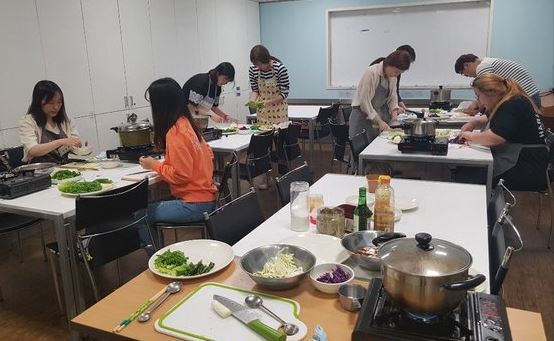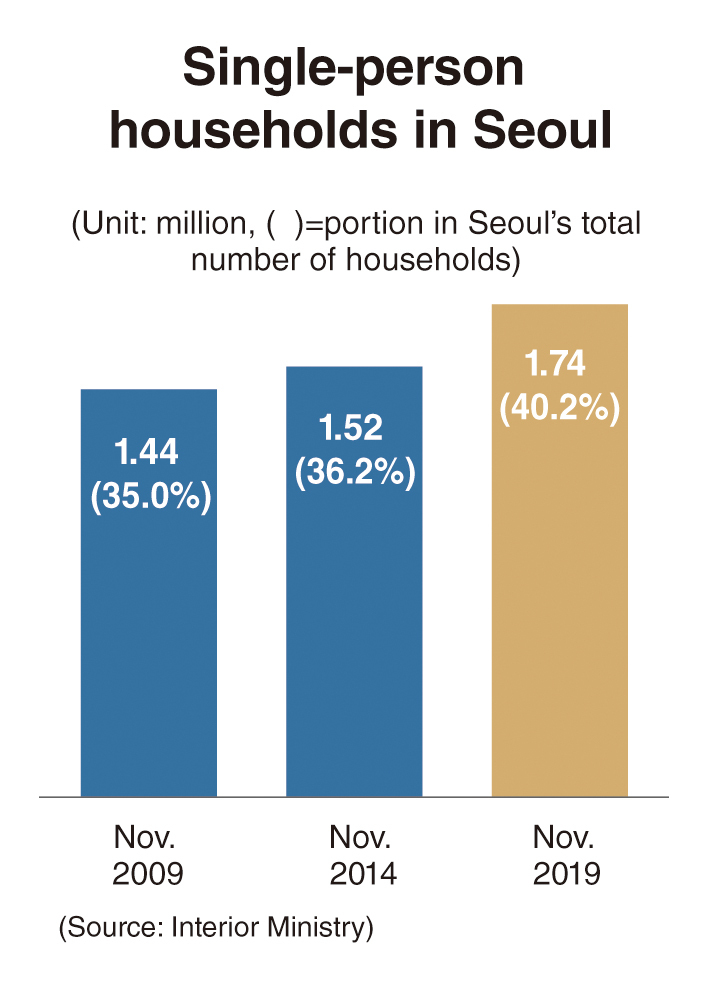[News Focus] Number of Seoulites residing alone up 300,000 in 10 years
By Kim Yon-sePublished : Dec. 9, 2019 - 15:56
SEJONG -- The number of residents in Seoul stood at 9.73 million as of November 2019, according to the Ministry of Interior and Safety. This is estimated to be the lowest figure in more than 30 years.
Given unofficial statistics showing that Seoul was home to 9.2 million in 1983 and 10.28 million in 1988, the current population level is assumed to be similar to that seen in the years between 1984 and 1987.
Compared to the figure of 10.21 million in November 2009, the population of the capital of South Korea fell by 480,000, or 4.7 percent, in a decade.
The figure started sliding in the 2010s after continuously hovering above 10 million in the 1990s and 2000s: In April 2011, Seoul had 10.25 million registered residents, but its population has seen a steady decline since. It recorded 10.11 million in November 2014, 9.87 million in November 2017, 9.77 million in November 2018 and 9.73 million in April 2019.
Given unofficial statistics showing that Seoul was home to 9.2 million in 1983 and 10.28 million in 1988, the current population level is assumed to be similar to that seen in the years between 1984 and 1987.
Compared to the figure of 10.21 million in November 2009, the population of the capital of South Korea fell by 480,000, or 4.7 percent, in a decade.
The figure started sliding in the 2010s after continuously hovering above 10 million in the 1990s and 2000s: In April 2011, Seoul had 10.25 million registered residents, but its population has seen a steady decline since. It recorded 10.11 million in November 2014, 9.87 million in November 2017, 9.77 million in November 2018 and 9.73 million in April 2019.

Ministry data showed that the number of Seoulites dropped below 10 million for the first time in 28 years in May 2016, when the figure posted 9.99 million.
Unlike the population drop, Seoul saw the number of single-person households rapidly grow over the past decade.
The number of people residing alone in the capital stayed at 1.44 million in November 2009. But it climbed to 1.52 million in November 2014 and 1.74 million in November 2019.
Since 2009, the number of single-person households has increased by 300,000, while the population has decreased by 480,000 in Seoul.
“Many households whose family members are two or more have moved to satellite cities in Gyeonggi Province due to high apartment prices,” a government official said. “The growth of single-person households in Seoul is attributed to the unmarried young generation in their 20s and 30s working or studying in Seoul amid low marriage rates and fertility rates.”
The one-member households took up 40.2 percent of total households (4.32 million) in Seoul last month, compared to 36.2 percent five years earlier and 35 percent 10 years earlier. The 2019 figure for the capital exceeds the nationwide average of 37.6 percent in the percentage of people residing alone of the total households for the corresponding month.

The 37.6 percent refers to 8.45 million single households of the total households, 22.44 million, as of last month across the country, which is up from 33.9 percent (7.03 million) in November 2014 and 31.9 percent (6.15 million) in November 2009.
This indicates that Korea saw the number of people who reside alone shoot up 2.3 million in a decade, despite minimal growth in total population and the number of all households.
The trend of one-member households in Seoul and more regions nationwide is in line with low fertility rates, alongside rapidly growing number of seniors residing alone.
Korea recorded a birthrate of 1.654 children per woman in 1993, when the government officially started compiling the data. The figure was still regarded as an endurable level in terms of backing up the potential working-age population, though it is estimated to have surpassed 2.0 in the early 1980s and 4.0 in the early 1970s, according to unofficial statistics.
But the birthrate posted a further decline in the 1990s and 2000s to come down to 1.187 in 2013. The figure for 2018 fell below the 1.0 mark for the first time in history at 0.977, according to Statistics Korea.
A noteworthy point is -- among eight major cities and nine provinces -- Seoul posted the lowest of 0.761 last year.
According to the Interior Ministry, the number of South Koreans aged 14 or under accounted for only 12.5 percent of the total population in November.
The demographic database held by the ministry includes classification into three groups -- those aged up to 14, those aged 15-64 (labeled the working-age population) and those aged 65 or over (seniors).
The data showed that the percentage of the youngest generation has continued to fall over the past decade. The figures were 14.2 percent five years earlier in October 2014 and 16.6 percent in October 2009.
By Kim Yon-se (kys@heraldcorp.com)








![[KH Explains] How should Korea adjust its trade defenses against Chinese EVs?](http://res.heraldm.com/phpwas/restmb_idxmake.php?idx=644&simg=/content/image/2024/04/15/20240415050562_0.jpg&u=20240415144419)










![[Today’s K-pop] Stray Kids to return soon: report](http://res.heraldm.com/phpwas/restmb_idxmake.php?idx=642&simg=/content/image/2024/04/16/20240416050713_0.jpg&u=)